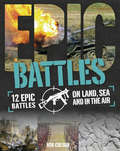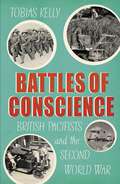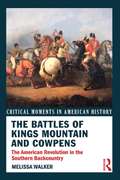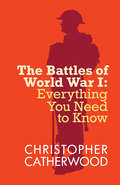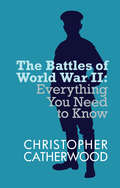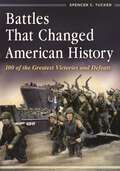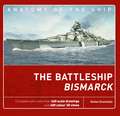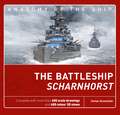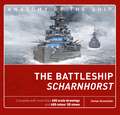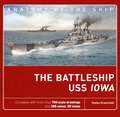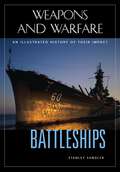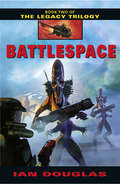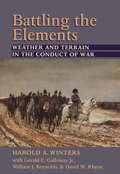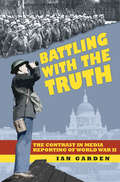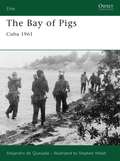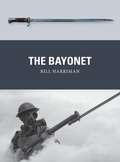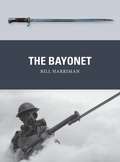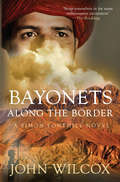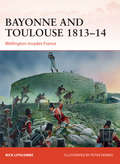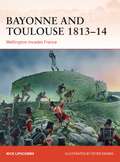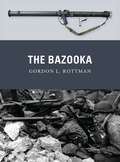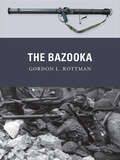- Table View
- List View
Battles: Battles (library Ebook) (Epic! #2)
by Rob ColsonEpic: Battles focuses on 12 of the biggest and most brutal battles in the history of the world, from Thermopylae in 480 BCE right the way through to Operation Desert Storm in 1991, taking in Cannae, Agincourt, Lepanto, the Siege of Yorktown, Trafalgar, Waterloo, Gettysburg, the Somme, the Battle of Britain and the Siege of Stalingrad. The book details the date and location of each battle, the opposing forces involved and the casualties resulting. A timeline on every spread gives the key dates from each battle, and what happened when. Additional background information to each conflict is also provided, including the Punic Wars, the Hundred Years' War, the American Revolution, the Napoleonic Wars, the American Civil War, World War 1, World War 2 and the first Gulf War.Epic: Battles also looks at the technology, tactics and weaponry involved in each battle, from the longbow at Agincourt and the galleasses at Lepanto to the trench warfare of the Somme and the stealth fighter jets of the Gulf War.Infographic elements on each spread present information in a simple and highly visual way. Clear, concise text and a bright, appealing design make the book the perfect resource for project work on battles, warfare and military history, or simply a great leisure read, for children aged 9 and above.For more epic events, try reading the other titles in the Epic series: Animal Migrations, Empires and Explorers.
Battles of Conscience: British Pacifists and the Second World War
by Tobias KellyA ground-breaking new study brings us a very different picture of the Second World War, asking fundamental questions about ethical commitmentsAccounts of the Second World War usually involve tales of bravery in battle, or stoicism on the home front, as the British public stood together against Fascism. However, the war looks very different when seen through the eyes of the 60,000 conscientious objectors who refused to take up arms and whose stories, unlike those of the First World War, have been almost entirely forgotten.Tobias Kelly invites us to spend the war five of these individuals: Roy Ridgway, a factory clerk from Liverpool; Tom Burns, a teacher from east London; Stella St John, who trained as a vet and ended up in jail; Ronald Duncan, who set up a collective farm; and Fred Urquhart, a working-class Scottish socialist and writer. We meet many more objectors along the way -- people both determined and torn -- and travel from Finland to Syria, India to rural England, Edinburgh to Trinidad.Although conscientious objectors were often criticised and scorned, figures such as Winston Churchill and the Archbishop of Canterbury supported their right to object, at least in principle, suggesting that liberty of conscience was one of the freedoms the nation was fighting for. And their rich cultural and moral legacy -- of humanitarianism and human rights, from Amnesty International and Oxfam to the US civil rights movement -- can still be felt all around us. The personal and political struggles carefully and vividly collected in this book tell us a great deal about personal and collective freedom, conviction and faith, war and peace, and pose questions just as relevant today: Does conscience make us free? Where does it take us? And what are the costs of going there?
The Battles of Kings Mountain and Cowpens: The American Revolution in the Southern Backcountry (Critical Moments in American History)
by Melissa A. WalkerThe American South is so identified with the Civil War that people often forget that the key battles from the final years of the American Revolution were fought in Southern states. The Southern backcountry was the center of the fight for independence, but backcountry devotion to the Patriot cause was slow in coming. Decades of animosity between coastal elites and backcountry settlers who did not enjoy accurate representation in the assemblies meant a complex political and social milieu throughout this turbulent time. The Battles of Kings Mountain and Cowpens brings to light the world of the Southern backcountry that engendered its role in the Revolutionary War. With careful attention to political, social, and military history, Walker concentrates on the communities and events not typically covered in books on the Revolutionary War. Through government documents, autobiographies, correspondence, and diaries, The Battles of Kings Mountain and Cowpens gives students of the Revolution an important new perspective on the role of the South in the resolution of the fighting.
The Battles of Kings Mountain and Cowpens: The American Revolution in the Southern Backcountry (Critical Moments in American History)
by Melissa A. WalkerThe American South is so identified with the Civil War that people often forget that the key battles from the final years of the American Revolution were fought in Southern states. The Southern backcountry was the center of the fight for independence, but backcountry devotion to the Patriot cause was slow in coming. Decades of animosity between coastal elites and backcountry settlers who did not enjoy accurate representation in the assemblies meant a complex political and social milieu throughout this turbulent time. The Battles of Kings Mountain and Cowpens brings to light the world of the Southern backcountry that engendered its role in the Revolutionary War. With careful attention to political, social, and military history, Walker concentrates on the communities and events not typically covered in books on the Revolutionary War. Through government documents, autobiographies, correspondence, and diaries, The Battles of Kings Mountain and Cowpens gives students of the Revolution an important new perspective on the role of the South in the resolution of the fighting.
The Battles of World War I (Everything You Need to Know)
by Christopher CatherwoodOur understanding of the twentieth century and beyond hinges upon the First World War. In this new and comprehensive book, the fascinating facts are presented in an accessible way, allowing anyone to brush up on the devastating conflict that changed the world we live in. Discover everything you need to know about: The battle of Ypres The Somme The forgotten wars between Italy, Austria and Russia The invention of the tank and how it changed the war The role of the USA The siege of Kut The battle the Germans won and much more . . .
The Battles of World War II: Everything You Need to Know Series (Everything You Need to Know Series #2)
by Christopher CatherwoodThe Second World War is without parallel in human history. The sheer carnage is staggering, with some estimating over 80 million people died as a result of the conflict. Catherwood brings an objective, informative voice to the vast detail on the subject of the war’s key battles, allowing you appreciate how it shaped the world we live in today. Discover everything you need to know about: The prelude to war, The Battle of Britain, The USA’s entry into the war, The Battle of Stalingrad, The Battles in Asia; Iwo Jima, Hiroshima and Nagasaki and much more.
Battles That Changed American History: 100 of the Greatest Victories and Defeats
by Spencer C. TuckerA fascinating and informative analysis by a distinguished military historian of the 100 most influential battles in American history, presented in an accessible, ready-reference format.The Battle of Okinawa (April–June 1945) resulted in more U.S. Navy casualties than all of the navy's previous wars combined; these heavy casualties influenced the decision to employ the atomic bomb against Japan that August. This is just one of many instances in American military history when the outcome of a battle helped to establish the course of history—the focus of this latest encyclopedia from esteemed historian Spencer C. Tucker. The 100 battles spotlighted in this work—which include defeats as well as victories—are deemed to have had the greatest impact on American history. Spanning more than 500 years of military events, the book begins its coverage with the Battle of Mabila in 1540 during the Age of Discovery and ends with the Second Battle of Falluja during the Iraq War/Insurgency in 2004. Expertly written, informative, and thoughtful, this analysis will be insightful and interesting for all high school, undergraduate, and general readers.
Battles That Changed American History: 100 of the Greatest Victories and Defeats
by Spencer C. TuckerA fascinating and informative analysis by a distinguished military historian of the 100 most influential battles in American history, presented in an accessible, ready-reference format.The Battle of Okinawa (April–June 1945) resulted in more U.S. Navy casualties than all of the navy's previous wars combined; these heavy casualties influenced the decision to employ the atomic bomb against Japan that August. This is just one of many instances in American military history when the outcome of a battle helped to establish the course of history—the focus of this latest encyclopedia from esteemed historian Spencer C. Tucker. The 100 battles spotlighted in this work—which include defeats as well as victories—are deemed to have had the greatest impact on American history. Spanning more than 500 years of military events, the book begins its coverage with the Battle of Mabila in 1540 during the Age of Discovery and ends with the Second Battle of Falluja during the Iraq War/Insurgency in 2004. Expertly written, informative, and thoughtful, this analysis will be insightful and interesting for all high school, undergraduate, and general readers.
The Battleship Bismarck (Anatomy of The Ship #1)
by Stefan DraminskiThe Bismarck is perhaps the most famous – and notorious - warship ever built. Completed in 1941, the 45,000-ton German battleship sunk HMS Hood, the pride of the British Navy, during one of the most sensational encounters in naval history. Following the sinking, Bismarck was chased around the North Atlantic by many units of the Royal Navy. She was finally dispatched with gunfire and torpedoes on 27 May, less than five months after her completion. Her wreck still lies where she sank, 4,800m down and 960km off the west coast of France. Drawing on new research and technology, this edition is the most comprehensive examination of Bismarck ever published. It includes a complete set of detailed line drawings with fully descriptive keys and full-colour 3D artwork, supported by technical details, photographs and text on the building of the ship and a record of the ship's service history.
The Battleship Scharnhorst (Anatomy of The Ship)
by Stefan DraminskiThe Kriegsmarine's Scharnhorst was a German capital ship, described either as a battleship or battlecruiser, and the lead ship of her class, which included one other ship, Gneisenau. She was launched on 3 October 1936 and completed in January 1939, armed with nine 28cm C/34 guns in three triple turrets. She operated with Gneisenau for much of the early portion of World War II, including sorties into the Atlantic to raid British merchant shipping. They took part in Operation Weserübung (April–June 1940), the German invasion of Norway, during which they sank the aircraft carrier HMS Glorious and her escort destroyers Acasta and Ardent. Scharnhorst also sank HMS Rawalpindi in November 1939. In early 1943, Scharnhorst joined the Tirpitz in Norway to intercept Allied convoys to the Soviet Union. On a sortie from Norway to attack a convoy, the German force was intercepted by British ships and during the Battle of the North Cape (26 December 1943), HMS Duke of York and her escorts sank Scharnhorst. Most of her crew was lost. This is the most comprehensive examination of Scharnhorst ever published, drawing on new research and technology to tell the full story of the ship. It includes a complete set of detailed line drawings with fully descriptive keys and full-colour 3D artwork, supported by technical details, photographs, and text on the building of the ship, as well as a record of her service history.
The Battleship Scharnhorst (Anatomy of The Ship)
by Stefan DraminskiThe Kriegsmarine's Scharnhorst was a German capital ship, described either as a battleship or battlecruiser, and the lead ship of her class, which included one other ship, Gneisenau. She was launched on 3 October 1936 and completed in January 1939, armed with nine 28cm C/34 guns in three triple turrets. She operated with Gneisenau for much of the early portion of World War II, including sorties into the Atlantic to raid British merchant shipping. They took part in Operation Weserübung (April–June 1940), the German invasion of Norway, during which they sank the aircraft carrier HMS Glorious and her escort destroyers Acasta and Ardent. Scharnhorst also sank HMS Rawalpindi in November 1939. In early 1943, Scharnhorst joined the Tirpitz in Norway to intercept Allied convoys to the Soviet Union. On a sortie from Norway to attack a convoy, the German force was intercepted by British ships and during the Battle of the North Cape (26 December 1943), HMS Duke of York and her escorts sank Scharnhorst. Most of her crew was lost. This is the most comprehensive examination of Scharnhorst ever published, drawing on new research and technology to tell the full story of the ship. It includes a complete set of detailed line drawings with fully descriptive keys and full-colour 3D artwork, supported by technical details, photographs, and text on the building of the ship, as well as a record of her service history.
The Battleship USS Iowa (Anatomy of The Ship)
by Stefan DraminskiUSS Iowa (BB-61) was the lead ship in one of the most famous classes of battleships ever commissioned into the US Navy. Transferred to the Pacific Fleet in 1944, the Iowa first fired her guns in anger in the Marshall Islands campaign, and sunk her first enemy ship, the Katori. The Iowa went on to serve across a number of pivotal Pacific War campaigns, including at the battles of the Philippine Sea and Leyte Gulf. The ship ended the war spending several months bombarding the Japanese Home Islands before the surrender in August 1945.After taking part in the Korea War, the Iowa was decommissioned in 1958, before being briefly reactivated in the 1980s as part of President Reagan's 600-Ship Navy Plan. After being decommissioned a second and final time in 1990, the Iowa is now a museum ship in Los Angeles.This new addition to the Anatomy of the Ship series is illustrated with contemporary photographs, scaled plans of the ship and hundreds of superb 3D illustrations which bring every detail of this historic battleship to life.
The Battleship USS Iowa (Anatomy of The Ship #16)
by Stefan DraminskiUSS Iowa (BB-61) was the lead ship in one of the most famous classes of battleships ever commissioned into the US Navy. Transferred to the Pacific Fleet in 1944, the Iowa first fired her guns in anger in the Marshall Islands campaign, and sunk her first enemy ship, the Katori. The Iowa went on to serve across a number of pivotal Pacific War campaigns, including at the battles of the Philippine Sea and Leyte Gulf. The ship ended the war spending several months bombarding the Japanese Home Islands before the surrender in August 1945.After taking part in the Korea War, the Iowa was decommissioned in 1958, before being briefly reactivated in the 1980s as part of President Reagan's 600-Ship Navy Plan. After being decommissioned a second and final time in 1990, the Iowa is now a museum ship in Los Angeles.This new addition to the Anatomy of the Ship series is illustrated with contemporary photographs, scaled plans of the ship and hundreds of superb 3D illustrations which bring every detail of this historic battleship to life.
Battleships: An Illustrated History of Their Impact (Weapons and Warfare)
by Stanley L. SandlerFrom ancient times to World War II and the postwar period, Battleships charts the evolution of the vessel that ruled the seas—a vessel that, until the arrival of the aircraft carrier, would be the most expensive and complex human-made moving object in history.Battleships charts the dramatic evolution of this dominating war vessel. Coverage ranges from ancient galleys to the great ships of World War II to the present, with special emphasis on the ironclad era of the mid-19th century (which saw the greatest innovation over the shortest timespan in naval history) and the great 20th-century battleship race of the dreadnought era.Written by expert military historian Stanley Sandler, Battleships provides insightful examinations of the technological and tactical aspects of important warships from around the world and across time. It also looks at the political and social factors driving the decision to produce battleships in different countries. No other volume has ever captured so completely the impact of the battleship as a weapon of war and a symbol of power.
Battlespace: Book Two Of The Legacy Trilogy (The Legacy Trilogy #2)
by Ian DouglasWhen called to do battle many light years from home, the 1st Marine Interstellar Expeditionary Unit rose to the challenge – and now thousands of enslaved humans have been freed, but the earth has moved on…
Battling the Elements: Weather and Terrain in the Conduct of War
by Harold A. WintersThroughout history, from Kublai Khan's attempted invasions of Japan to Rommel's desert warfare, military operations have succeeded or failed on the ability of commanders to incorporate environmental conditions into their tactics. In Battling the Elements, geographer Harold A. Winters and former U.S. Army officers Gerald E. Galloway Jr., William J. Reynolds, and David W. Rhyne, examine the connections between major battles in world history and their geographic components, revealing what role factors such as weather, climate, terrain, soil, and vegetation have played in combat. Each chapter offers a detailed and engaging explanation of a specific environmental factor and then looks at several battles that highlight its effects on military operations. As this cogent analysis of geography and war makes clear, those who know more about the shape, nature, and variability of battleground conditions will always have a better understanding of the nature of combat and at least one significant advantage over a less knowledgeable enemy.
Battling With the Truth: The Contrast in the Media Reporting of World War II
by Ian Garden‘Think of the press as a great keyboard on which the government can play.’ – Joseph Goebbels, Reich Minister of Public Enlightenment and Propaganda Dunkirk, Stalingrad, the Dieppe Raid: there were many bloody and gruesome conflicts fought during the Second World War, yet there was one vital and aggressive battle in which no blood was directly shed – that of the warring nations’ battle with the truth. In Battling With the Truth (a follow-up to The Third Reich’s Celluloid War) Ian Garden offers fascinating insights into the ways by which both the Axis and Allies manipulated military and political facts for their own ends. By analysing key incidents and contemporary sources from both British and German perspectives, he reveals how essential information was concealed from the public. Asking how both sides could have believed they were fighting a just war, Garden exposes the extent to which their peoples were told downright lies or fed very carefully worded versions of the truth. Often these ‘versions’ gave completely false impressions of the success or failure of missions – even whole campaigns. Ultimately, Battling With the Truth demonstrates that almost nothing about war is as clear-cut as the reporting at the time makes out. From the past, we can learn valuable lessons about the continuing potential for media manipulation and political misinformation – especially during wartime.
The Bay of Pigs: Cuba 1961 (Elite)
by Stephen Walsh Alejandro De QuesadaThe landings by the Cuban exile Assault Brigade 2506 at the Bay of Pigs on April 17, 1961 led to three days of savage but unequal combat. Before they even sailed for Cuba, a White House decision had condemned them to constant attacks by Castro's air force, which sank two of their ships loaded with vital supplies and equipment. Despite stubborn resistance to Castro's troops and tanks, and heroic sorties by Cuban and American B-26 pilots, the Brigade was strangled for lack of firepower and ammunition. Their story is illustrated with rare photos from Brigade veterans, and detailed color plates of the uniforms and insignia of both sides.
The Bayonet (Weapon)
by Bill HarrimanAlthough muskets delivered devastating projectiles at comparatively long ranges, their slow rate of fire left the soldier very vulnerable while reloading, and early muskets were useless for close-quarter fighting. Consequently, European infantry regiments of the 17th century were composed of both musketeers and pikemen, who protected the musketeers while loading but also formed the shock component for close-quarter combat. The development of the flintlock musket produced a much less cumbersome and faster-firing firearm. When a short knife was stuck into its muzzle, every soldier could be armed with a missile weapon as well as one that could be used for close combat. The only disadvantage was that the musket could not be loaded or fired while the plug bayonet was in place. The socket bayonet solved this problem and the musket/bayonet combination became the universal infantry weapon from c.1700 to c.1870. The advent of shorter rifled firearms saw the attachment of short swords to rifle barrels. Their longer blades still gave the infantryman the 'reach' that contemporaries believed he needed to fend off cavalry attacks. The perfection of the small-bore magazine rifle in the 1890s saw the bayonet lose its tactical importance, becoming smaller and more knife-like, a trend that continued in the world wars. When assault rifles predominated from the 1950s onwards, the bayonet became a weapon of last resort. Its potential usefulness continued to be recognized, but its blade was often combined with an item with some additional function, most notably a wire-cutter. Ultimately, for all its fearsome reputation as a visceral, close-quarter fighting weapon, the bayonet's greatest impact was actually as a psychological weapon. Featuring full-colour artwork as well as archive and close-up photographs, this is the absorbing story of the complementary weapon to every soldier's firearm from the army of Louis XIV to modern-day forces in all global theatres of conflict.
The Bayonet (Weapon)
by Bill HarrimanAlthough muskets delivered devastating projectiles at comparatively long ranges, their slow rate of fire left the soldier very vulnerable while reloading, and early muskets were useless for close-quarter fighting. Consequently, European infantry regiments of the 17th century were composed of both musketeers and pikemen, who protected the musketeers while loading but also formed the shock component for close-quarter combat. The development of the flintlock musket produced a much less cumbersome and faster-firing firearm. When a short knife was stuck into its muzzle, every soldier could be armed with a missile weapon as well as one that could be used for close combat. The only disadvantage was that the musket could not be loaded or fired while the plug bayonet was in place. The socket bayonet solved this problem and the musket/bayonet combination became the universal infantry weapon from c.1700 to c.1870. The advent of shorter rifled firearms saw the attachment of short swords to rifle barrels. Their longer blades still gave the infantryman the 'reach' that contemporaries believed he needed to fend off cavalry attacks. The perfection of the small-bore magazine rifle in the 1890s saw the bayonet lose its tactical importance, becoming smaller and more knife-like, a trend that continued in the world wars. When assault rifles predominated from the 1950s onwards, the bayonet became a weapon of last resort. Its potential usefulness continued to be recognized, but its blade was often combined with an item with some additional function, most notably a wire-cutter. Ultimately, for all its fearsome reputation as a visceral, close-quarter fighting weapon, the bayonet's greatest impact was actually as a psychological weapon. Featuring full-colour artwork as well as archive and close-up photographs, this is the absorbing story of the complementary weapon to every soldier's firearm from the army of Louis XIV to modern-day forces in all global theatres of conflict.
Bayonets Along the Border: A Simon Fonthill Novel (Simon Fonthill #10)
by John WilcoxNorth West India, July 1897. Simon and Alice Fonthill are travelling with their old friend Jenkins to Marden, India for a 50th anniversary party with the Guides Corps. What begins as a peaceful journey becomes a dangerous battle as they find themselves ambushed by four Pathans. On arrival at Marden, their suspicions of conflict are confirmed as they are told of fresh trouble from the Pathans leading Simon and his comrade, 352 Jenkins, to join the charge in protecting a nearby fort.Afterwards, their respite is short-lived when Simon is tasked by Viceroy Elgin to deliver a very important letter to the Amir in Kabul. For her safety, Alice only travels as far as fort Landi Kotal in the Khyber Pass. But strife prevails throughout the land; tribe fights with tribe and every man is a soldier ready to bloody his hands. Undertaking his mission in Kabul, Fonthill learns from the Amir that an army is heading towards the Pass to seize the forts and will undoubtedly leave most for dead.Can Fonthill and Jenkins battle their way back across the Pass to the fort? And will they make it in time to rescue Alice or will the merciless Pathans get there first?
Bayonne and Toulouse 1813–14: Wellington invades France (Campaign #266)
by Peter Dennis Colonel Nick LipscombeThe news of Wellington's momentous victory at Vitoria on 21 June 1813 reached London in early July. Celebration spawned an expectation of a rapid conclusion to events in the Peninsula. His Majesty's Government gave authority for Wellington to invade France and made noises and plans for the redeployment of the Peninsular Army in support of Russia and Prussia. Wellington, however, did not see things in quite the same way. His army was worn out and there remained sizeable French forces in Spain, so what followed had to be a carefully thought out and planned campaign. The invasion itself commenced with the daring Allied crossing of the Bidassoa estuary in early October 1813 and was followed by an operational pause prior to the Battle of Nivelle in November. The subsequent operations, which commenced early in 1814, provided the aftermath to the invasion and the conclusion to the Peninsular War. These actions focus primarily on the investment of Bayonne and the pursuit of Soult's army east, and include the battles and engagements at Garris, Orthez, Aire, Tarbes and the final showdown at Toulouse in April 1814.
Bayonne and Toulouse 1813–14: Wellington invades France (Campaign #266)
by Peter Dennis Nick LipscombeThe news of Wellington's momentous victory at Vitoria on 21 June 1813 reached London in early July. Celebration spawned an expectation of a rapid conclusion to events in the Peninsula. His Majesty's Government gave authority for Wellington to invade France and made noises and plans for the redeployment of the Peninsular Army in support of Russia and Prussia. Wellington, however, did not see things in quite the same way. His army was worn out and there remained sizeable French forces in Spain, so what followed had to be a carefully thought out and planned campaign. The invasion itself commenced with the daring Allied crossing of the Bidassoa estuary in early October 1813 and was followed by an operational pause prior to the Battle of Nivelle in November. The subsequent operations, which commenced early in 1814, provided the aftermath to the invasion and the conclusion to the Peninsular War. These actions focus primarily on the investment of Bayonne and the pursuit of Soult's army east, and include the battles and engagements at Garris, Orthez, Aire, Tarbes and the final showdown at Toulouse in April 1814.
The Bazooka (Weapon)
by Gordon L. Rottman Johnny Shumate Alan GillilandMost belligerents entering World War II armed their infantry with bulky and ineffectual anti-tank rifles as their primary means of combating tanks. US planners realized that what infantrymen needed was a relatively lightweight, man-portable anti-tank weapon that was simple to operate, accurate, and capable of knocking out the average tank at a reasonable range, while also being effective against fortified buildings, pillboxes, and personnel in the open. The bazooka combined a revolutionary new anti-tank rifle-grenade warhead, a much-modified British anti-aircraft rocket motor, and a cobbled-together launcher tube and electrical firing system; its first test-firing astounded observers, and it was immediately adopted by the US armed forces. Featuring specially drawn colour artwork, this engaging study tells the story of the bazooka, which set the standard for future light anti-tank weapons and their ammunition, and was a key influence on anti-tank tactics and techniques in the post-war era.
The Bazooka (Weapon)
by Gordon L. Rottman Johnny Shumate Alan GillilandMost belligerents entering World War II armed their infantry with bulky and ineffectual anti-tank rifles as their primary means of combating tanks. US planners realized that what infantrymen needed was a relatively lightweight, man-portable anti-tank weapon that was simple to operate, accurate, and capable of knocking out the average tank at a reasonable range, while also being effective against fortified buildings, pillboxes, and personnel in the open. The bazooka combined a revolutionary new anti-tank rifle-grenade warhead, a much-modified British anti-aircraft rocket motor, and a cobbled-together launcher tube and electrical firing system; its first test-firing astounded observers, and it was immediately adopted by the US armed forces. Featuring specially drawn colour artwork, this engaging study tells the story of the bazooka, which set the standard for future light anti-tank weapons and their ammunition, and was a key influence on anti-tank tactics and techniques in the post-war era.
